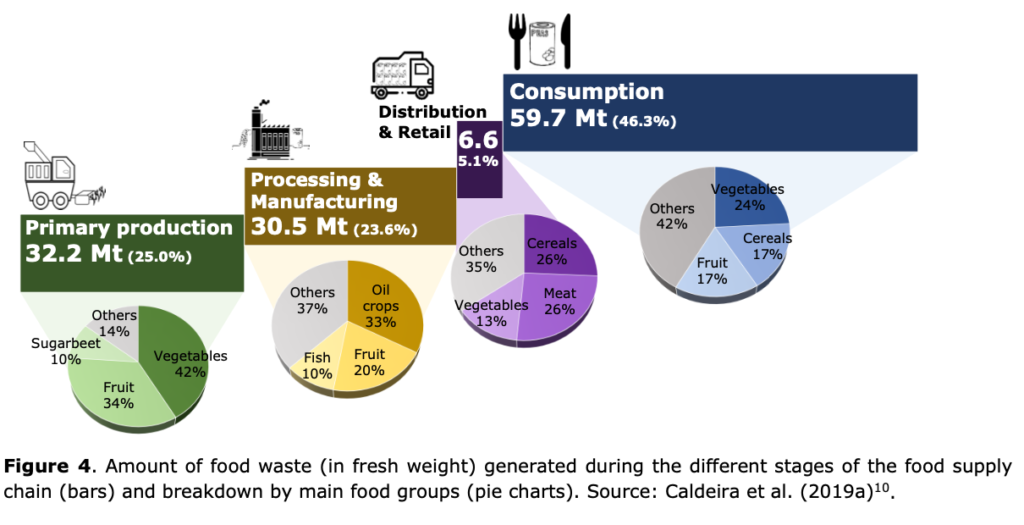Using data from 2011, Calderia et al. (2019) break down and analyse EU food waste by food group. The study found that about 638 million tonnes (Mt) of food was generated in 2011, of which 129 Mt became classified as food waste. That means that about 20% of the total food produced that year went to waste. To put that into perspective, the weight of food wasted in the EU in 2011 was about 20 times the weight of the Great Pyramid of Giza, and 400 times as heavy as the Empire State Building.
—

Amount of food waste (fresh weight) generated during the different stages in the supply chain (bars), and breakdown by main food group (pie charts). Source: Sanchez et al (2020).
Calderia et al. (2019) broke down food waste along the supply chain and found that the most waste (46.3%) is produced at the consumer level, and 46% of this waste is of fruit and vegetables.
A large part of why so much food waste is concentrated in households stems from a misunderstanding of the meaning behind ‘best before’ and ‘use by’ labelling. Food is often still safe to eat after the ‘best before’ date, whereas ‘use by’ is meant to be a harder deadline. Confusion and misunderstanding about these labels encourage wasteful behaviours surrounding food, as some safe and edible foods are prematurely disposed of and wasted.
Another major issue concerning food waste is marketing. ‘Buy One, Get One’ and ‘Value Pack’ deals, especially for perishable goods, encourage customers to buy more than they need and more than they can consume before it expires.
From seemingly small and unimportant misunderstandings, a massive amount of food is lost. The nature of these issues makes us slow to address them, but the result means we should consider them more carefully.
Tackling Household Food Waste
Since consumer behaviour is generating the most significant proportion of food waste, it’s individuals who have the most power to enact meaningful change to the current system. Here are 5 simple ways to reduce household food waste:
- Plan ahead: Planning out your weekly meals can reduce food waste by encouraging people to buy only what they need and avoiding unnecessary foods which may go uneaten.
- Keep expiry dates in mind when shopping: Take notice of the use by and best before dates and only buy what you know you’ll use in time.
- Use your freezer! Freezing foods is a great way to meal prep and cut down on food waste.
- Get creative with unused produce: Vegetable and/or meat scraps can be used to make stock. Uneaten vegetables can be used in soups, and uneaten fruit can be turned into a smoothie.
- Compost: Check if your local government has a food waste or composting system you can add to.
Impact of Reducing Food Waste
Reducing food waste has significant environmental, social and economic benefits:
- Food waste is estimated to amount for 6% of greenhouse gas (GHG) emissions in the EU. Therefore an efficient food system can help reduce GHGs.
- A less wasteful food system will use significantly less land and water. In fact, the FAO estimates that 250km3 of water goes into producing food that is lost or wasted, equivalent to three times the volume of Lake Geneva.
- Reducing food waste plays a role in reducing worldwide hunger, as surplus food can be redistributed to those who lack access.
- Costs associated with EU food waste are estimated at €143billion every year.
This article was written by Lola Robinson.
You might also like: Bushmeat Hunting in South America
References
-
Caldeira et al (2019). Quantification of food waste per product group along the food supply chain in the European Union: a mass flow analysis. Resources, Conservation, and Recycling, 149, pp.479-488. Available at: https://www.sciencedirect.com
-
Sanchez, J., Caldeira, C., De Laurentiis, V., Sala, S. & Avraamides, M. (2020). Brief on food waste in the European Union. The European Commission’s Knowledge Center for Bioeconomy. https://www.researchgate.net
-
European Commission: https://ec.europa.eu
-
FAO: http://www.fao.org/news/story/en/item/196402/ico










![The Statistics of Biodiversity Loss [2020 WWF Report]](https://u4d2z7k9.rocketcdn.me/wp-content/uploads/2020/12/lprwinkyTHB-544x306.jpg)





